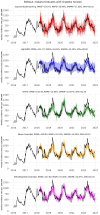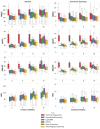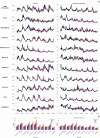Infectious disease forecasting to support public health: use of readily available methods to predict malaria and diarrhoeal diseases in Mozambique
- PMID: 40214148
- PMCID: PMC11997905
- DOI: 10.7189/jogh.15.04114
Infectious disease forecasting to support public health: use of readily available methods to predict malaria and diarrhoeal diseases in Mozambique
Abstract
Background: Mozambique faces a high burden of infectious diseases but currently has limited capacity for forecasting disease incidence. Recent improvements in disease surveillance through the National Monitoring and Evaluation System now provide weekly reports of disease incidence across the country's districts. This study focuses on using these records, specifically for malaria and diarrhoeal diseases, which together account for approximately 40% of deaths among children under five, to develop statistical forecasts and evaluate their accuracy.
Methods: We utilised a Python library for time series forecasting called Darts, which includes a variety of statistical forecasting models. Three models were selected for this analysis: Exponential Smoothing (a classical statistical model), Light Gradient Boosting Machine (a machine-learning model), and Neural Hierarchical Interpolation for Time Series (a neural network-based model). Retrospective forecasts were generated and compared across multiple forecast horizons. We evaluated both point and probabilistic forecast accuracy for individual models and two types of model ensembles, comparing the results to forecasts based on historical expectance.
Results: All models consistently outperformed forecasts based on historical expectance for both malaria and diarrhoeal disease across forecast horizons of up to eight weeks, with comparable or better performance at 16 weeks. The most accurate forecasts were achieved using a weighted ensemble of the models.
Conclusions: This study highlights the potential of using a readily available tool for generating accurate disease forecasts. It represents a step toward scalable and accessible forecasting solutions that can enhance disease surveillance and public health responses, not only in Mozambique but also in other low- and middle-income countries with similar challenges.
Copyright © 2025 by the Journal of Global Health. All rights reserved.
Conflict of interest statement
Disclosure of interest: The authors completed the ICMJE Disclosure of Interest Form (available upon request from the corresponding author) and disclose the following relationships: JS and Columbia University disclose partial ownership of SK Analytics.
Figures



Similar articles
-
Predictive performance of multi-model ensemble forecasts of COVID-19 across European nations.Elife. 2023 Apr 21;12:e81916. doi: 10.7554/eLife.81916. Elife. 2023. PMID: 37083521 Free PMC article.
-
Forecasting non-stationary diarrhea, acute respiratory infection, and malaria time-series in Niono, Mali.PLoS One. 2007 Nov 21;2(11):e1181. doi: 10.1371/journal.pone.0001181. PLoS One. 2007. PMID: 18030322 Free PMC article.
-
Global fertility in 204 countries and territories, 1950-2021, with forecasts to 2100: a comprehensive demographic analysis for the Global Burden of Disease Study 2021.Lancet. 2024 May 18;403(10440):2057-2099. doi: 10.1016/S0140-6736(24)00550-6. Epub 2024 Mar 20. Lancet. 2024. PMID: 38521087 Free PMC article.
-
Application progress of ensemble forecast technology in influenza forecast based on infectious disease model.Front Public Health. 2023 Dec 15;11:1335499. doi: 10.3389/fpubh.2023.1335499. eCollection 2023. Front Public Health. 2023. PMID: 38162616 Free PMC article. Review.
-
Selected Topics in Time Series Forecasting: Statistical Models vs. Machine Learning.Entropy (Basel). 2025 Mar 7;27(3):279. doi: 10.3390/e27030279. Entropy (Basel). 2025. PMID: 40149203 Free PMC article. Review.
References
-
- Human Development Reports. Human Development Index. Available: https://hdr.undp.org/data-center/human-development-index. Accessed: 16 January 2024.
-
- U.S. Agency for International Development. Global Health Mozambique; 2023. Available: https://www.usaid.gov/mozambique/global-health. Accessed: 17 January 2024.
-
- Bureau UC. Census.gov Mozambique: Population Vulnerability and Resilience Profile. Available: https://www.census.gov/programs-surveys/international-programs/data/popu.... Accessed: 11 March 2024.
-
- World Health Organization. World malaria report; 2022. Available: https://www.who.int/publications-detail-redirect/9789240064898. Accessed: 16 January 2024.
MeSH terms
Grants and funding
LinkOut - more resources
Full Text Sources
Medical
